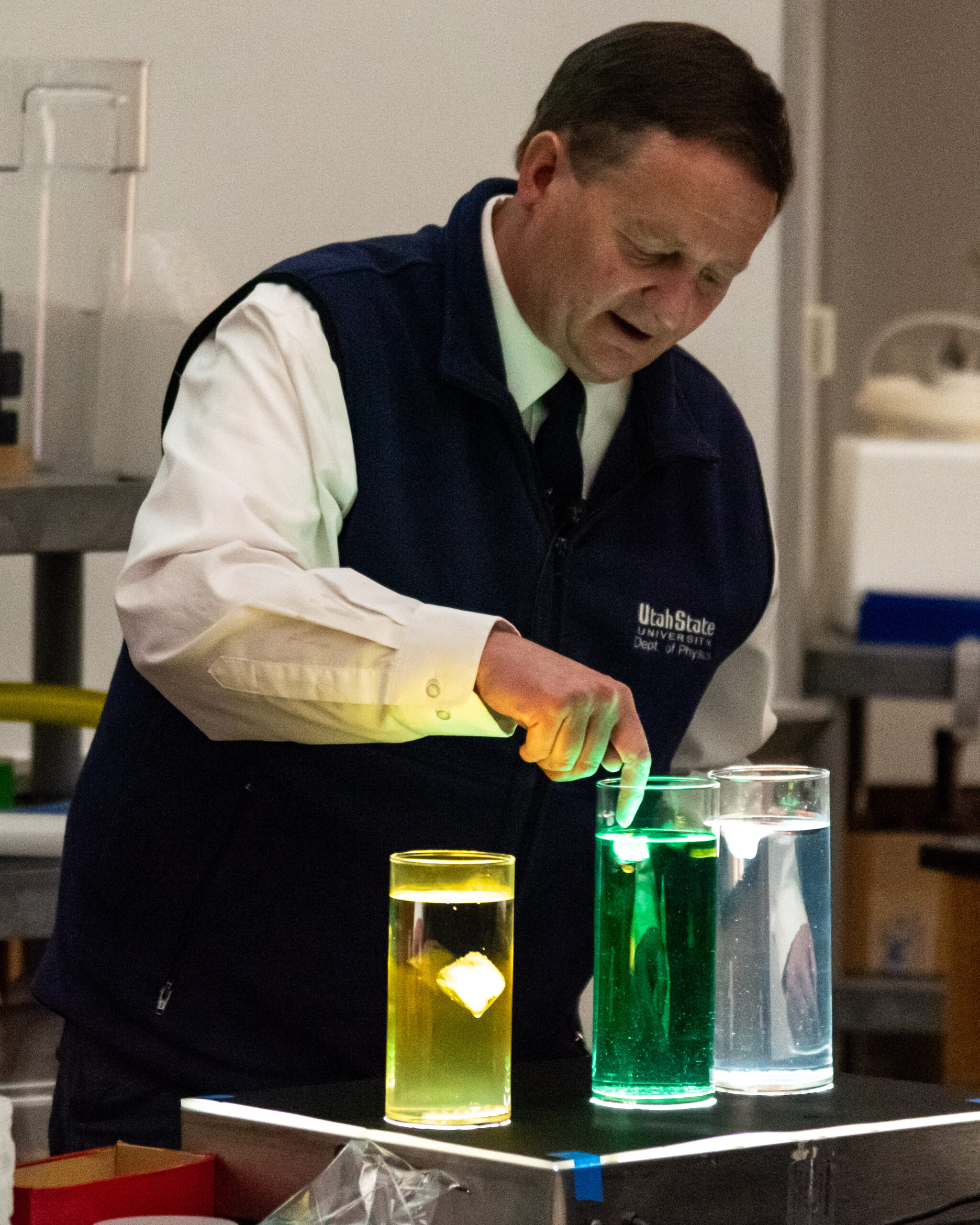Between phases of the annual physics demo
On Friday, Nov. 22, the Utah State University Physics Department held its annual Physics November Demo Show to an amazed audience.
It was held in the Emert Auditorium in the Eccles Science Learning Center.
The show was hosted by James Coburn, the education program coordinator for the department.
The shows are demonstrations of physics concepts for the general public and free for all who wish to attend. 450 people attended to watch the show.
The shows are patterned off the UK’s Christmas lectures done by The Royal Institution of Great Britain, where a topic is chosen, and a demonstration show is done on that topic.
“I wanted to do something similar to that,” Coburn said. “By Christmas, there are no students around, so I moved it up to the week before Thanksgiving.”
The goal for the show is to both teach the general public as well as entertain people at the same time, according to Coburn. In addition, many schools have requested Coburn to do these demonstrations, but time constraints prevent Coburn from making the trips.
“So I decided I would do a big one,” Coburn said. “And that big show would be open to anybody in the public.”
This year, the theme was “The Physics of Phase Transitions.” This focused on phase changes and the processes by which matter changes its state. This includes topics such as freezing, boiling and melting, as well as how these can occur in rather bizarre scenarios.
“There was a neat demo where he got a flask and he had some liquid water in the top and some vapor in the flask, and then he put one end of the flask in liquid nitrogen,” said Joshua Knobloch, assistant professor of the department and attendee of the show.
Although the flask had water far outside of the reach of the liquid nitrogen, the water at the top began to stir before freezing instantly. This occurred due to the transfer of energy done by the vapors within the flask, which cannot be seen by the naked eye.
“I mean, it’s science,” Knobloch said. “But maybe from an outside perspective, it almost looked like magic, as if the water instantly froze.”
Liquid nitrogen and dry ice were recurring features but were not the only demonstrations within the show, with more mundane examples that can be done at home being shown.
“I put an ice cube in salt water and in regular water and then watch how long it takes to melt,” Coburn said. “I put an ice cube in two different types of oil, and the ice cube sat in the middle, and then water dripped and fell down,”
The reason for the ice cube to drip downwards is because water is denser than oil, so the oil will float to the top, and the water will move downwards.
Other experiments were not recommended to try at home.
One that wasn’t allowed within the show was the crushing of a 55-gallon drum. In the experiment, warm water is placed into a drum and then sealed shut. It then is placed in ice water, with ice cubes on top. It will finally be sprayed with water, creating atmospheric pressure changes, resulting in the drum being crushed.
Concerns were raised by both the fire marshal and other staff about the experiment, so the demo was not done. However, footage of the experiment was shown instead.
“2020 and pandemic, we couldn’t have a show, so I got a high-speed camera, and I filmed physics in slow motion, and that’s still on YouTube,” Coburn said. “I took the video clips from that.”
While the gallon-drum experiment couldn’t be done in person, Coburn was glad a video clip could be shown, as it included thermals, data for the experiment and a high-speed camera.
In addition, smaller-scale versions of the drum experiment were done with soda cans, and a petrol can instead of a drum was used instead.
As each experiment and demonstration was done, Coburn would explain some of the science behind the demonstration in a way someone at any level of scientific understanding could understand.
“I think James did a great job of catering to the multiple levels that were in the audience,” Knobloch said.
As for next year, plans and a topic have already been chosen.
“It’s going to be based around angular momentum, spinning physics, rotating physics so that everything will have a spin to it,” Coburn said when asked about next year’s show.

